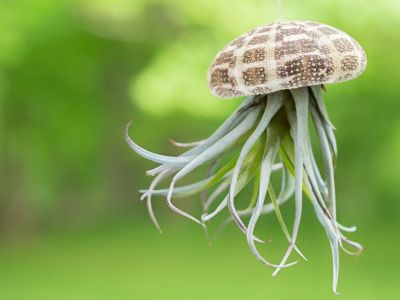What are Jellyfish Succulents?
The arrangement is put together with at least two types of succulents. One type will be a cascading plant that will grow out to resemble jellyfish tentacles. The other type is often echeverias or any type of succulent rosette plant that remains close to the soil. For a jellyfish that can stay outside year-round, use hens and chicks with stonecrop sedums for the tentacles. The jellyfish hanging succulent can be created from any type of succulent (or others) you have on hand if they don’t grow tall. The only thing that you must use are cascading plants to serve as the tentacles of the jellyfish. You can also create one of these jellyfish lookalikes with air plants and sea urchin shells. Use your creativity to put together your own unique jellyfish succulent arrangement.
How to Make Jellyfish Succulents
To start with, you’ll need the right type of hanging basket. Using a coir-lined hanging basket that can be turned inside out to resemble the body of the jellyfish is a common recommendation. Some suggest using an appropriately spaced sheet of wire to help hold these plants in place. Then, cover with soil or put all the soil in first and then plant with the wire holding the dangling plants. When using the wire, danglers are often planted in the middle of the pot. Others suggest the use of sewing staples to hold them. Again, whatever is easiest for you with the items you have. You’ll cover the bottom of the upside-down basket with a felt covering held in place by a thin wire, threaded around the edges. Keep in mind the covering holds the soil in place. It gets heavier when wet, so make sure your felt is strong enough for that task and held in place securely. Double thread the wire for extra hold.
Planting the Jellyfish Succulent Hanging Planter
You may also plant through the felt into small slits you’ve cut. This would be appropriate if you use unrooted cuttings and allow them to root before turning the basket upside down. Once upside down, cut small slits through which to insert the root system until it reaches the soil. Again, this is easier to do if using unrooted cuttings, but rooted plants can be used through the slits too. Some gardeners accomplish the look without turning the container upside down. This is done with pruning techniques to keep the top rounded. Plants for the tentacles are grown around the edges. Some use plants other than succulents. Whichever way you plant the jellyfish container, it looks better once it has some growth.
